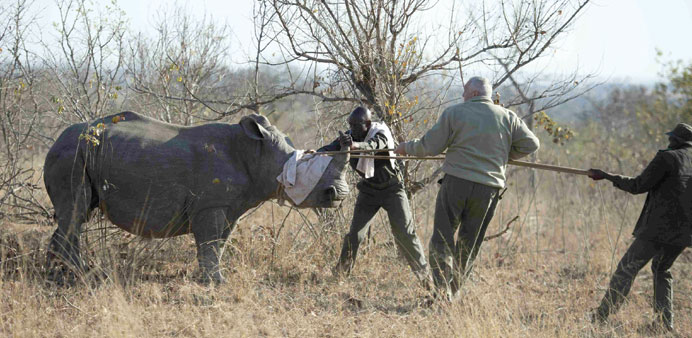By Ed Stoddard, Reuters/Kruger National Park, South Africa
As a helicopter hovers above, men emerge from the bush, using rope to haul a one-tonne male white rhino they have sedated with a dart fired from the air.
The animal is one of hundreds to be moved from “hotspots” in South Africa’s Kruger National Park where they are at risk from soaring demand for rhino horn.
“Our priority is to move the animals from ‘hot spots’ near the boundary fence,” said Markus Hofmeyr, the head vet for South African National Parks.
While a public backlash rages against a Minnesota dentist who killed Zimbabwe’s Cecil the lion, Hofmeyr’s focus is not on wealthy big game hunters but on the poachers who killed over 1,200 rhinos in South Africa last year.
That was a fourfold increase over 2010, due largely to increasing demand for rhino horn in newly affluent Asian countries such as Vietnam where it is prized in traditional medicine.
Most of the poachers are drawn from neighbouring Mozambique, which borders the Kruger and remains one of the world’s poorest nations despite huge gas and coal finds.
South Africa is home to over 80% of the world’s rhino population with over 20,000. About 5,000 of these are on private reserves, whose owners derive an income from ecotourism and legal hunts and could earn a new income steam if the ban on trade in rhino horn is ever lifted.
After Hofmayr’s team coaxes a sedated rhino to a dirt road, they gently tip it over and set about drilling a hole into the horn to install a microchip. If it is subsequently poached and the horn removed, it can be traced.
Hofmeyr also hurriedly draws blood from the animal for research. Then the rhino is brought to its feet and led by rope about 40m to a waiting crate, to be lifted by crane onto a flatbed truck.
The basic methods of capturing rhino remain the same as in the early 1960s, when the Kruger - then seen as a “safe haven” - was restocked with white rhinos from the Umfolozi Game Reserve to the south.
Mortality rates were high during the early efforts to capture live rhinos. Now the operations use safer drugs and one witnessed by Reuters was completed in just over an hour, with darting and tracking done from helicopters.
For security reasons, the exact locations of the darting operations, precise removal numbers and the rhinos’ new homes are kept private. The government has previously said it might move 200 this year to “strongholds.”
“Rhinos really aren’t safe anywhere,” said Hofmeyr.

A white rhino being captured by conservation officials in South Africa’s Kruger National Park.


